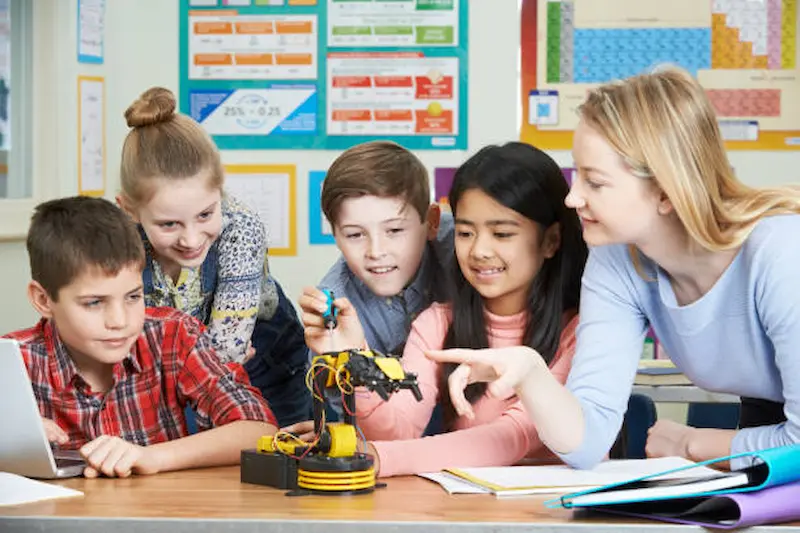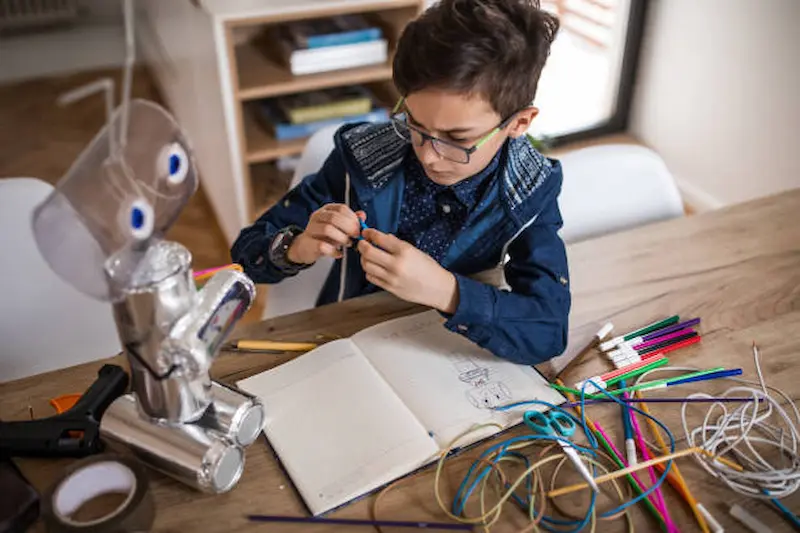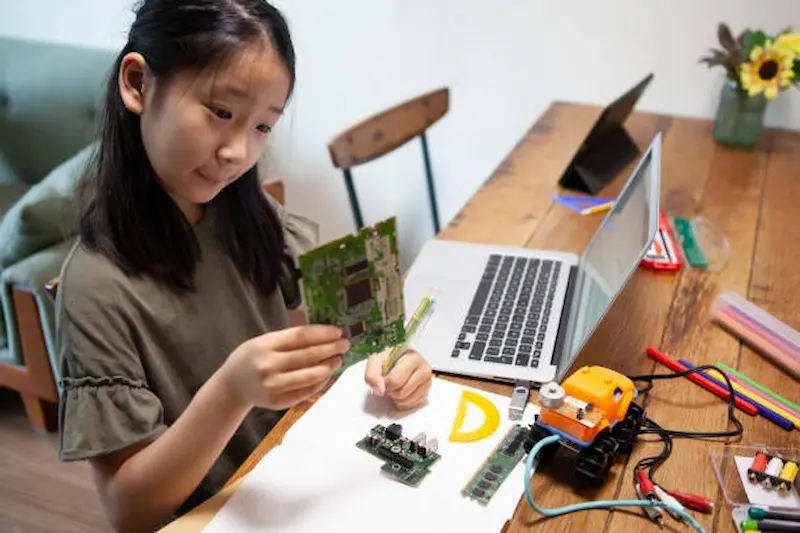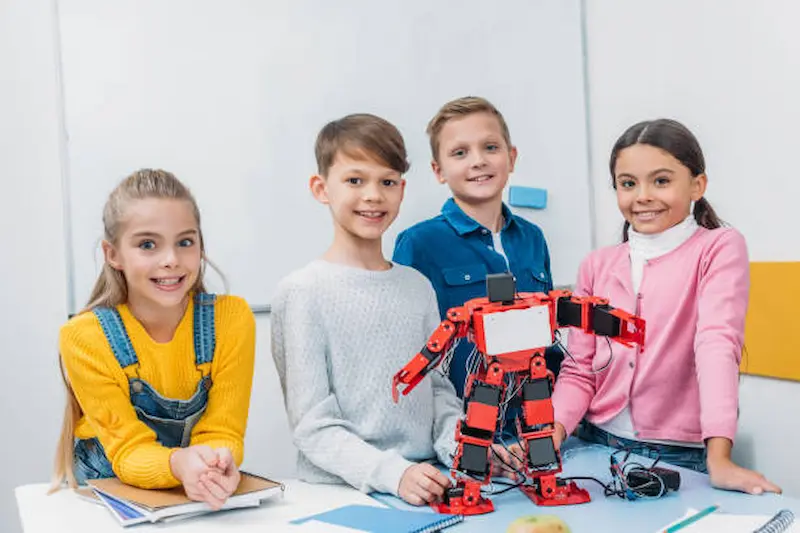Robotics education at the elementary level fosters crucial skills like critical thinking, problem-solving, and creativity, preparing students for a technology-driven future. To engage young learners effectively, a curriculum that integrates age-appropriate robotics, STEAM principles, and creative teaching strategies is essential, ensuring that students remain enthusiastic and well-prepared for the challenges of tomorrow.
In this blog, we explore the significance of a robotics curriculum for elementary kids, emphasizing the role it plays in developing essential 21st-century skills, promoting STEM learning, and sparking curiosity and innovation in young minds.
Table of contents
- Understanding Elementary Students
- Designing a Unique Robotics Curriculum
- Key Components of the Curriculum
- Engaging Elementary Students
- Unique Teaching Strategies
- Assessing Progress and Learning Outcomes
- Teacher Training and Support
- Overcoming Challenges
- Future Directions
- Conclusion
- Frequently Asked Questions ( FAQs )
Understanding Elementary Students

A. Cognitive Development in Elementary Age
Elementary students, typically aged 6 to 12, undergo significant cognitive development. Piaget’s stages of development apply here, with concrete operational thinking emerging. This stage allows children to solve complex problems, think logically, and understand cause-and-effect relationships, thereby fostering critical thinking skills for kids. Teachers should tailor lessons to stimulate their cognitive growth by providing hands-on experiences, real-world applications, and opportunities for critical thinking, ensuring they are well-equipped for future challenges.
B. The Role of Robotics in Enhancing Learning
Robotics has emerged as a powerful tool for enhancing elementary education, extending its benefits to early childhood learning. It engages students in science, technology, engineering, and mathematics (STEM) concepts through hands-on activities. Robots encourage creativity, problem-solving, and teamwork, making abstract concepts tangible and fostering a deeper understanding of complex subjects. Additionally, robotics sparks enthusiasm, making learning fun and memorable. As technology continues to advance, integrating robotics into the curriculum can equip elementary students, even those in early childhood learning, with valuable skills for the future.
Designing a Unique Robotics Curriculum

A. Core Principles of the Curriculum
A robust robotics curriculum, featuring activities for kids, hinges on core principles: sequential learning, hands-on exploration, and real-world applications. Each lesson should build upon the previous one, allowing students to grasp complex concepts progressively while engaging in activities for kids. Hands-on activities with robots enable students to experiment, fail, and learn from their mistakes, enhancing their problem-solving skills. Real-world applications connect classroom knowledge to practical use, making the curriculum more relevant and engaging for kids.
B. Integrating STEAM (Science, Technology, Engineering, Arts, and Mathematics)
STEAM integration enriches the robotics curriculum, making science for kids an engaging and well-rounded experience. Incorporating arts fosters creativity and innovation, turning STEM into STEAM. Encourage students to design and decorate their robots, blending aesthetics with functionality. This holistic approach to education ensures a well-rounded and comprehensive learning experience, preparing elementary students, including science for kids, for a dynamic future.
Key Components of the Curriculum

A well-structured robotics curriculum comprises essential components designed to engage students and foster their growth:
A. Robotics Kits and Hardware
Providing students with access to robotics kits and hardware, especially robotics kits for kids, is fundamental. These tools allow students to get hands-on experience, understand the mechanics of robotics, and build technical proficiency. Choosing age-appropriate kits ensures that students, especially robotics kits for kids, can work with technology that matches their skill levels and prevents frustration or boredom, ensuring an engaging and educational experience.
B. Age-Appropriate Software and Programming
The curriculum should incorporate age-appropriate software and programming platforms. Younger elementary students benefit from visual programming tools that simplify coding and emphasize logical thinking. Older students can delve into more advanced languages.
The right software allows students to program robots, execute commands, and see their code in action, making learning interactive and engaging.
C. Hands-On Projects and Challenges
Engaging students with hands-on projects and challenges, especially robotics projects for kids, is a cornerstone of a successful robotics curriculum. It encourages problem-solving, teamwork, and creativity. Students should work on practical projects, including robotics projects for kids, that apply their knowledge and skills, such as building obstacle-avoiding robots or designing robotic art. These challenges motivate students, stimulate their curiosity, and offer a tangible way to measure progress, making the learning experience both fun and educational.
D. Creative and Critical Thinking Activities
Incorporating creative and critical thinking activities within the curriculum is vital, not only for building technical proficiency but also for leadership skills for kids. These activities foster imagination and analytical skills, encouraging students to think outside the box by designing their robots or solving complex problems. Robotics serves as a conduit for developing creative solutions, and critical thinking enhances decision-making abilities. This holistic approach equips students with the skills they need for future success, ensuring that they become well-rounded learners and problem-solvers, ready to develop leadership skills for kids as well.
Engaging Elementary Students

A. Gamification and Learning
Gamification strategies, such as incorporating online games for kids into instruction, can engage primary school pupils. Teachers add aspects like points, competitions, and awards to make learning more engaging and inspiring. Gamified activities, including online games for kids, encourage engagement and simplify difficult subjects for participants to understand and retain, making the educational experience both enjoyable and effective.
B. Collaborative Learning
Collaboration and communication are enhanced through collaborative learning. Students are encouraged to exchange ideas, work through issues together, and learn from one another through group projects and peer interactions, which makes studying more interesting and social.
C. Real-World Problem Solving
Including real-world issues in lessons gives students a sense of direction and fosters positive thinking for kids. It enables students to realize how what they learn may be applied in real-world situations, inspiring them to investigate solutions, exercise critical thought, and apply their knowledge to real-world problems. This method not only increases participation but also expands their comprehension and encourages positive thinking for kids as they see the practical impact of their education.
Unique Teaching Strategies
A. Storytelling and Robotics
Incorporating storytelling into robotics education, especially robotics for kids, captures students’ imaginations. Narratives can guide lessons, framing challenges and missions, making learning more engaging and relatable, particularly for robotics for kids.
By merging storytelling with robotics, educators create a captivating learning experience that enhances comprehension and sparks creativity, ensuring that young learners find the subject intriguing and enjoyable.
B. Cross-Curricular Connections
Creating cross-curricular connections enriches the curriculum, with the inclusion of math games for kids being a valuable addition. Integrating robotics with other subjects, such as math, science, and art, offers a comprehensive learning experience. This approach reinforces knowledge transfer and highlights the interconnectivity of various fields, fostering a holistic understanding of the material. Including math games for kids in this interdisciplinary approach not only reinforces mathematical skills but also enhances the overall learning experience.
Assessing Progress and Learning Outcomes
Effective assessment is integral to any educational program, especially in a robotics curriculum for kids. It’s crucial to evaluate both the progress and learning outcomes of students. Use a variety of assessment methods, such as quizzes, projects, and peer evaluations, to gauge their understanding and practical skills, making quizzes for kids an essential part of the process. Encourage students to reflect on their experiences, identifying areas for improvement. By assessing their progress, educators can adapt instruction and ensure that students achieve the intended learning outcomes, enhancing the overall educational experience.
Teacher Training and Support

A. Preparing Educators for the Unique Curriculum
To successfully implement a robotics curriculum, it’s imperative to prepare educators adequately. This unique curriculum requires specialized training to navigate the world of robotics and effectively guide students. Training should cover the basics of robotics, software and hardware operation, safety protocols, and classroom management. Equipping teachers with this knowledge empowers them to inspire and educate young minds, fostering a stimulating learning environment.
B. Ongoing Professional Development
Robotics is an ever-evolving field, especially in a robotics class for kids. To keep pace with technological advancements and teaching methodologies, ongoing professional development is essential. Workshops, conferences, and online courses help educators in a robotics class for kids to stay current and share best practices.
Collaboration with peers within and beyond the school community enhances knowledge sharing. Continuous professional development ensures that teachers, especially in robotics courses for kids, can provide the most relevant and engaging education, equipping students with the skills they need to thrive in a rapidly changing world. This approach fosters a dynamic learning environment, helping students develop a strong foundation in robotics and technology.
Overcoming Challenges
In any endeavor, challenges are inevitable, and teaching kids kindness in the face of these challenges is crucial. When dealing with difficulties, it’s essential to maintain resilience and problem-solving skills. Identify specific issues, such as technology limitations or student engagement hurdles, and develop tailored solutions. Collaboration among educators can provide fresh perspectives and share successful strategies. Additionally, staying updated on educational trends and adapting to changing circumstances ensures a proactive approach to challenges, ultimately leading to improved learning outcomes and professional growth, all while instilling the values of teaching kids kindness in the process.
Future Directions

The future of robotics education promises exciting possibilities, especially with the advent of online robotics for kids. To stay relevant, curriculum designers must keep pace with ever-evolving technology. Emerging fields like artificial intelligence and automation will likely become integral components, and online robotics for kids can facilitate this transition. Interdisciplinary connections will strengthen, making robotics a bridge between various subjects. Additionally, addressing ethical considerations and environmental concerns in robotics, both in traditional and online robotics for kids, will become vital. Future directions should focus on preparing students for a dynamic, technologically advanced world, fostering adaptability and ethical consciousness.
Conclusion
A robotics curriculum for elementary kids is an educational program designed to introduce young students to the world of robotics, teaching them about hardware, software, and problem-solving through hands-on activities. This curriculum offers benefits that include fostering critical thinking, enhancing STEM skills, encouraging creativity, and preparing children for a tech-savvy future.
To get your hands on more educational and free resources on coding for kids, robotics for kids, financial education for kids, etc., do check out the BrightCHAMPS Page now!
To get your hands on more such articles, educational content, and free resources on coding for kids, robotics courses, game development, etc., check out the BrightCHAMPS Blog Page now!
Frequently Asked Questions ( FAQs )
A1. The “Building Young Innovators” robotics curriculum is designed to nurture creativity, problem-solving, and STEM skills in students through hands-on robotics projects.
Q2. Who is the target audience for this curriculum?
A2. The target audience for this curriculum is elementary students, typically in the 6 to 12 age group.
Q3. What makes this curriculum unique compared to others available in the market?
A3. This curriculum stands out due to its focus on fostering creativity and innovation through age-appropriate, hands-on projects, making it engaging for young learners.
Q4. Can teachers with no prior robotics experience use this curriculum effectively?
A4. Yes, teachers with no prior robotics experience can use this curriculum effectively as it provides training and resources to guide educators through the teaching process.
Q5. Are there specific robotics kits or materials required for this curriculum?
A5. Specific robotics kits and materials are required, tailored to different age groups, ensuring an engaging and progressive learning experience.


 We are an army of educators and passionate learners from BrightChamps family, committed to providing free learning resources to kids, parents & students.
We are an army of educators and passionate learners from BrightChamps family, committed to providing free learning resources to kids, parents & students.












